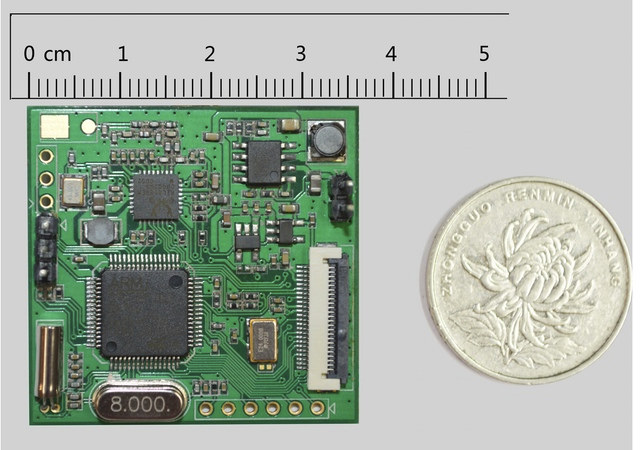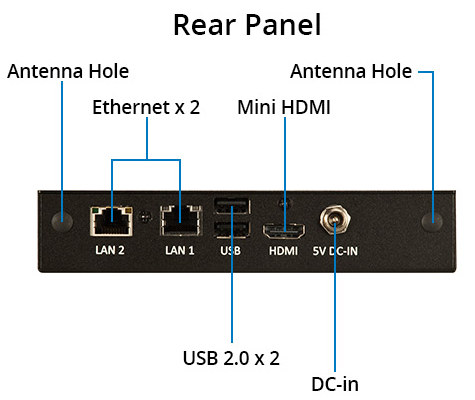After last week formal launch of Texas Instruments Sitara AM572x processor, and Beagleboard-X15 development board, Compulab has now introduced CL-SOM-AM57x System-on-Module based on TI Sitara AM5718 or AM5728 SoC, as well as the corresponding SBC-AM57x single board computer. Both target industrial automation and control systems, and network connectivity options also make them suitable for networking, communications and IoT applications. CL-SOM-AM57X module specifications: SoC – Texas Instruments Sitara AM5728 or AM5718 SoC with: Dual (AM5728) or single (AM5718) Cortex A15 processor @ up to 1.5 GHz Dual core PowerVR SGX544 3D GPU, Vivante GC320 2D GPU Two Cortex M4 cores @ 212 MHz Dual TMS320C66x DSP @ 700 MHz Video IVA-HD 1080p video sub-system Four 32-bit PRUs (Programmable Real-time Units) System Memory – 512MB to 4GB DDR3 Storage – 4 to 32GB on-board eMMC, 512MB to 1GB on-board SLC NAND Connectivity – On-board WiFi 802.11a/b/g/n + Bluetooth 4.1 BLE (TI WiLink […]
Freescale Kinetis KW41Z Wireless MCU Supports Bluetooth 4.2, Zigbee, and Thread
Freescale has unveiled a new wireless micro-controller part of their Kinetis MCU family with Kinetis KW41Z, based on an ARM Cortex M0+ core, and supporting both the latest Bluetooth 4.2 specifications, as well as a 802.15.4 radio allowing support for Zigbee and Thread. Kinetis KW41Z main features and specifications: ARM Cortex-M0+ core @ 48 MHz, with up to 512 KB Flash memory, up to 128 KB SRAM, and an integrated balun Multi Protocol Radio 2.4 GHz radio, Bluetooth Low Energy 4.2 compliant IEEE 802.15.4-2011 standard compliant radio Receiver Sensitivity (Typ.) – BLE: -96 dBm; 802.15.4: -102 dBm Programmable Transmitter Output Power up to +4 dBm I/Os – 2x I2C, 2x SPI, LPUART, TSI, CMT and GPIOs with interrupt capabilities Analog modules – 16-bit ADC, 12-bit DAC, 6-bit High Speed Analog Comparator (CMP) Security – AES-128 Accelerator (AESA), True Random Number Generator (TRNG) Operating Voltage Ranges Bypass Voltage: 1.71V to 3.6V […]
Marvell EZ-Connect MW302 IoT Starter Kit Supports AWS IoT Cloud Services
Amazon has just launched AWS (Amazon Web Services) IoT (Beta), a cloud platform that lets connected devices securely interact with cloud applications and other IoT devices. As pasrt of the announcement, they also released AWS IoT SDK that comes in three flavors: Embedded C SDK for C-based platforms such as Linux, RTOS, with variants for OpenSSL and mbed TLS. JavaScript SDK in Node.js Arduino Yún SDK. Ten started kits are currently officially supported by AWT IoT, many of them being existing platforms such as LinkIt One, BeagleBone Green, Intel Edison, or TI LaunchPad CC3200, with several of these kits including SeeedStudio’s Grove modules. One of the kits that’s completely new, at least to me, is Marvell EZ-Connect MW302 IoT Starter Kit which include a mini USB to USB cable, and Marvell 88MW302 development board with the following (preliminary) specifications: SoC – Marvell EZ-Connect MW302 ARM Cortex-M4 WiSoC with 512KB SRAM […]
Vigek IOT Core is a Tiny STM32 WiFi Board with a Camera Interface, GPIOs, PWM, and Analog Inputs
Vigek IOT Core packs an STM32 MCU, a Realtek WiFi module, and 8-bit camera interface into a 3.6×3.75 cm board. It also provides GPIO, PWM, and analog input to interface with external hardware such as sensors, and the project had a modest, yet successful, Kickstarter campaign in the summer. Vigek IOT Core specifications: MCU – STMicro STM32F103 ARM Cortex-M3 micro-controller @ up to 72MHz Connectivity – 802.11b/g/n WiFi @ 54Mbps I/Os Up to 8 GPIOs, configurable as up to 4 analog inputs, and up to 6 PWM outputs I/O voltage tolerance – 0~3.6V I/O output current – Up to 8mA Camera – 8-bit camera interface, optional 2.0MP camera with OV2640 sensor Power supply – 3.3V ~ 24V Power Consumption – 32mA in active mode (WIFI connected, camera not working) Dimensions – 36mm x 37.5mm While Vigtek IOT Core can be used without programming, simply using an Android app to control the […]
Archos Introduces Free PicoWAN IoT Gateway, Costing 75 Cents Per Year Per Connected Device
The Internet of Things is promising billions of connected devices in the next few years, and while devices at home can usually connect through your broadband connection at no extra cost, devices on the field may need to use cellular connectivity and cheap 2G network are being phased out by Telcos. Weightless, operating over white space frequencies, is one of several solutions proposed to connect IoT objects over longer distances, but Archos has their own project with PicoWAN pico-gateways using LoRa(WAN) protocol which allows for several kilometers range. PicoWAN would plug into your wall socket, connect to your broadband network over WiFI and offer connectivity to various “things” over LoRa. Creating a cellular network is expensive, due to the costs of base stations, but PicoWAN is so cheap, 100 times cheap than traditional base stations, that Archos plans to giveaway 200,000 gateways across Europe to create an IoT network. That […]
Kinoma HD is $25 TV Stick Devkit Based on Marvell ARMADA 1500 Mini Plus Processor
Marvell has just revealed that ChromeCast 2.0 & Audio featured their ARMADA 1500 Mini Plus (88DE3006) processor with two ARM Cortex A7 cores, coupled with 512 MB RAM, and Avastar 88W8887 wireless solution with WiFi 802.11 b/g/n/ac, Bluetooth 4.1, NFC and FM radio. But a comment on Anandtech lead me to a development kit based on 88DE3006 I missed while I was away: Kinoma HD. Preliminary hardware specifications: SoC – Marvell ARMADA 1500 Mini Plus (88DE3006) dual core Cortex A7 @ 1.2 GHz with 3D GPU supporting OpenGL ES 1.1/2.0, Qdeo video engine System Memory – 256 MB RAM Storage – TBD Video Output – HDMI output of 1080p/720p Connectivity – Wi-Fi g/n/ac Power Supply – 5V via micro USB port Apart for the lower memory capacity (256MB vs 512MB), Kinoma HD hardware looks pretty similar to ChromeCast 2.0. But the main difference is in the software, as while ChromeCast […]
Axiomtek PICO842 Fanless Bay Trail Pico-ITX Motherboard Includes a SO-DIMM Socket and SATA Ports
Axiomtek PICO842 is a fanless Pico-ITX motherboard that features Intel Celeron J1900 quad core processor or Celeron N2807 dual core processor with up to 8GB DDR3L, and aimed at IoT & medical applications, automation, and embedded systems with wide temperature range requirements. Axiomtek PICO842 specifications: SoC Intel Celeron J1900 quad core processor up to 2.42 GHz OR Intel Celeron N2807 dual core processor up to 2.16 GHz System Memory – 1x DDR3L-1066/1333 SO-DIMM up to 8GB for J1900, and 4GB for N2807 Storage – 1x SATA-300, 1x mSATA Video Output – 1x 18/24-bit single/dual channel LVDS, and 1x HDMI or 1x VGA Audio – HD Codec audio (Realtek ALC662); MIC-in/Line-out Connectivity – Gigabit Ethernet (Intel i211AT) USB – 4x USB 2.0 host port Serial – 2x COM ports supporting RS-232, RS-422, and RS-485. Expansion – mini PCI Express (shared with mSATA support) Power Supply – 12V DC power jack. Battery […]
VIA Artigo A820 Enterprise IoT Gateway Is Powered by Freescale i.MX 6DualLite Processor
VIa has just launched a new fanless IoT gateway targeting the enterprise market. Artigo A820 features Freescale i.MX 6DualLite Cortex A9 processor with dual Ethernet ports as well as DIO and serial ports, and optional wireless networking modules adding WiFi, 3G, and GPS connectivity. Artigo A820 specifications: SoC – Freescale i.MX 6DualLite dual core ARM Cortex-A9 @ 1.0 GHz with Vivante GC880 GPU System Memory – 1GB DDR3 SDRAM Storage – 4GB eMMC Flash + internal micro SD card Connectivity 1x Gigabit Ethernet (Micrel KSZ9031RNX with RGMII support) 1x 10/100M Ethernet (using ASIX AX88772 USB 2.0 to 10/100Mbps Fast Ethernet Controller), Optional VNT9271BU0DB IEEE 802.11 b/g/n USB Wi-Fi dongle Optional Ublox 3.75G HSPA/UMTS Mobile mini PCIe module with GPS and SIM card slot 2 Antenna holes for 3G or Wi-Fi Video Output – mini HDMI 1.4 USB – 3x USB 2.0 host ports Serial – 1x COM port for RS232/485; […]










